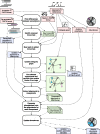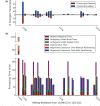Updating RNA-Seq analyses after re-annotation
- PMID: 23677943
- PMCID: PMC3694665
- DOI: 10.1093/bioinformatics/btt197
Updating RNA-Seq analyses after re-annotation
Abstract
The estimation of isoform abundances from RNA-Seq data requires a time-intensive step of mapping reads to either an assembled or previously annotated transcriptome, followed by an optimization procedure for deconvolution of multi-mapping reads. These procedures are essential for downstream analysis such as differential expression. In cases where it is desirable to adjust the underlying annotation, for example, on the discovery of novel isoforms or errors in existing annotations, current pipelines must be rerun from scratch. This makes it difficult to update abundance estimates after re-annotation, or to explore the effect of changes in the transcriptome on analyses. We present a novel efficient algorithm for updating abundance estimates from RNA-Seq experiments on re-annotation that does not require re-analysis of the entire dataset. Our approach is based on a fast partitioning algorithm for identifying transcripts whose abundances may depend on the added or deleted isoforms, and on a fast follow-up approach to re-estimating abundances for all transcripts. We demonstrate the effectiveness of our methods by showing how to synchronize RNA-Seq abundance estimates with the daily RefSeq incremental updates. Thus, we provide a practical approach to maintaining relevant databases of RNA-Seq derived abundance estimates even as annotations are being constantly revised.
Availability and implementation: Our methods are implemented in software called ReXpress and are freely available, together with source code, at http://bio.math.berkeley.edu/ReXpress/.
Supplementary information: Supplementary data are available at Bioinformatics online.
Figures



Similar articles
-
Identification of novel transcripts in annotated genomes using RNA-Seq.Bioinformatics. 2011 Sep 1;27(17):2325-9. doi: 10.1093/bioinformatics/btr355. Epub 2011 Jun 21. Bioinformatics. 2011. PMID: 21697122
-
TIGAR: transcript isoform abundance estimation method with gapped alignment of RNA-Seq data by variational Bayesian inference.Bioinformatics. 2013 Sep 15;29(18):2292-9. doi: 10.1093/bioinformatics/btt381. Epub 2013 Jul 2. Bioinformatics. 2013. PMID: 23821651
-
Computational approaches for isoform detection and estimation: good and bad news.BMC Bioinformatics. 2014 May 9;15:135. doi: 10.1186/1471-2105-15-135. BMC Bioinformatics. 2014. PMID: 24885830 Free PMC article.
-
SSP: an interval integer linear programming for de novo transcriptome assembly and isoform discovery of RNA-seq reads.Genomics. 2013 Nov-Dec;102(5-6):507-14. doi: 10.1016/j.ygeno.2013.10.003. Epub 2013 Oct 23. Genomics. 2013. PMID: 24161398
-
Benchmark analysis of algorithms for determining and quantifying full-length mRNA splice forms from RNA-seq data.Bioinformatics. 2015 Dec 15;31(24):3938-45. doi: 10.1093/bioinformatics/btv488. Epub 2015 Sep 3. Bioinformatics. 2015. PMID: 26338770 Free PMC article.
Cited by
-
Information transduction capacity reduces the uncertainties in annotation-free isoform discovery and quantification.Nucleic Acids Res. 2017 Sep 6;45(15):e143. doi: 10.1093/nar/gkx585. Nucleic Acids Res. 2017. PMID: 28911101 Free PMC article.
-
Bioinformatics and Drug Discovery.Curr Top Med Chem. 2017;17(15):1709-1726. doi: 10.2174/1568026617666161116143440. Curr Top Med Chem. 2017. PMID: 27848897 Free PMC article. Review.
-
Synergistically acting agonists and antagonists of G protein-coupled receptors prevent photoreceptor cell degeneration.Sci Signal. 2016 Jul 26;9(438):ra74. doi: 10.1126/scisignal.aag0245. Sci Signal. 2016. PMID: 27460988 Free PMC article.
-
Identification and Validation of Reference Genes in Clostridium beijerinckii NRRL B-598 for RT-qPCR Using RNA-Seq Data.Front Microbiol. 2021 Mar 18;12:640054. doi: 10.3389/fmicb.2021.640054. eCollection 2021. Front Microbiol. 2021. PMID: 33815328 Free PMC article.
-
Comparing bioinformatic gene expression profiling methods: microarray and RNA-Seq.Med Sci Monit Basic Res. 2014 Aug 23;20:138-42. doi: 10.12659/MSMBR.892101. Med Sci Monit Basic Res. 2014. PMID: 25149683 Free PMC article. Review.
References
-
- Asmann YW, et al. Detection of redundant fusion transcripts as biomarkers or disease-specific therapeutic targets in breast cancer. Cancer Res. 2012;72:1921–1928. - PubMed
-
- Bichot CE, Siarry P, editors. Graph Partitioning. Hoboken, NJ, USA: Wiley; 2011.
Publication types
MeSH terms
Substances
Grants and funding
LinkOut - more resources
Full Text Sources
Other Literature Sources

